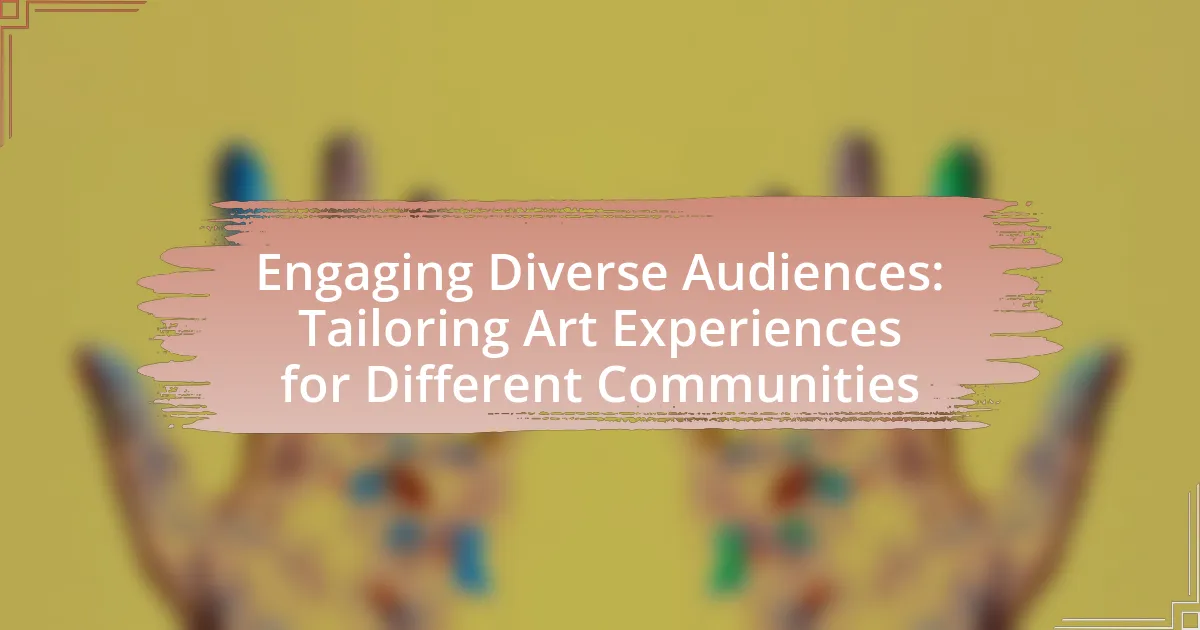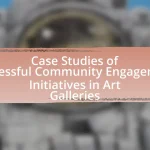The article focuses on the importance of engaging diverse audiences in art experiences by creating inclusive and accessible opportunities for individuals from various cultural, social, and economic backgrounds. It highlights the significance of tailoring art experiences to reflect the interests and values of different communities, which fosters inclusivity and enhances cultural relevance. Key factors influencing audience engagement, such as accessibility, relevance, interactivity, and emotional connection, are discussed, along with the challenges artists face in reaching diverse audiences. The article also outlines effective strategies for creating inclusive art experiences, the role of community input, and methods for measuring the impact of engagement efforts.
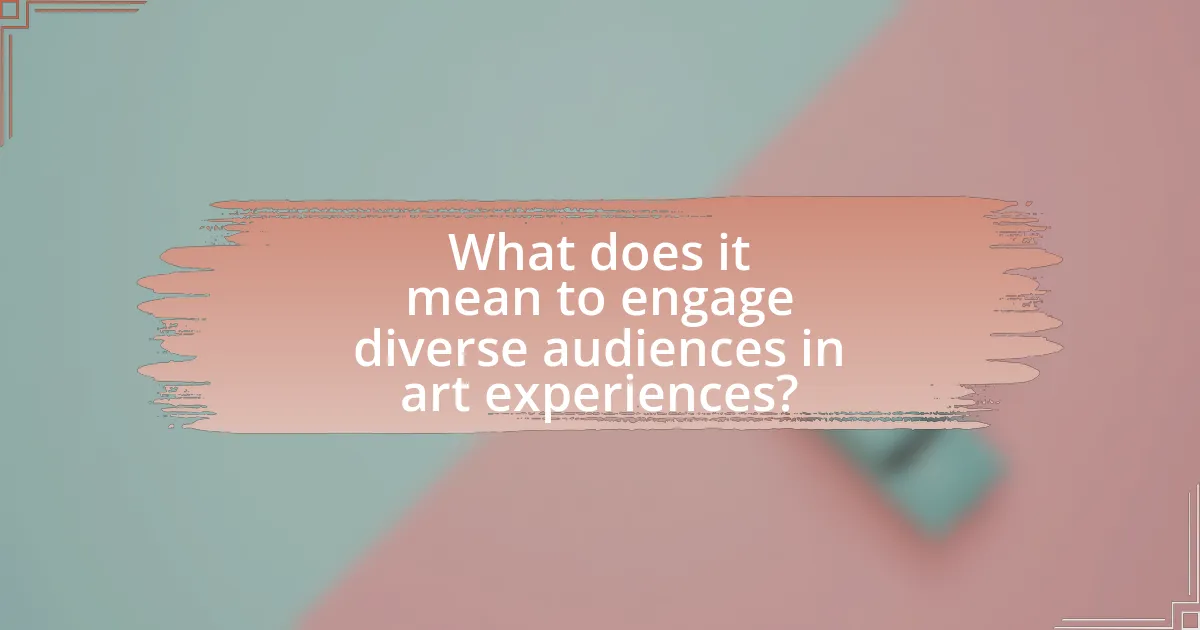
What does it mean to engage diverse audiences in art experiences?
Engaging diverse audiences in art experiences means creating inclusive and accessible opportunities for individuals from various cultural, social, and economic backgrounds to participate in and appreciate art. This approach recognizes the unique perspectives and needs of different communities, ensuring that art experiences resonate with a wide range of participants. For instance, research by the National Endowment for the Arts indicates that diverse programming can enhance community engagement and foster a sense of belonging among underrepresented groups. By tailoring art experiences to reflect the interests and values of diverse audiences, organizations can promote equity and enrich the cultural landscape.
Why is it important to tailor art experiences for different communities?
Tailoring art experiences for different communities is important because it fosters inclusivity and enhances cultural relevance. When art is customized to reflect the values, traditions, and interests of specific communities, it resonates more deeply with individuals, encouraging participation and engagement. Research indicates that culturally relevant art can increase community cohesion and promote social well-being, as seen in initiatives like the Urban Arts Program in Los Angeles, which successfully engaged diverse populations by incorporating local narratives into artistic expressions. This approach not only validates the identities of community members but also enriches the overall artistic landscape by introducing varied perspectives and experiences.
What are the key factors that influence audience engagement in art?
Key factors that influence audience engagement in art include accessibility, relevance, interactivity, and emotional connection. Accessibility ensures that art is physically and financially reachable for diverse audiences, which can significantly enhance participation. Relevance pertains to how well the art resonates with the cultural, social, and personal experiences of the audience, making it more meaningful. Interactivity allows audiences to participate actively, fostering a deeper connection with the artwork. Emotional connection is crucial, as art that evokes feelings can lead to a more profound engagement. Research indicates that these factors collectively enhance audience involvement and satisfaction, as seen in studies like “The Role of Audience Engagement in the Arts” by the National Endowment for the Arts, which highlights the importance of these elements in fostering a vibrant art community.
How do cultural backgrounds affect perceptions of art?
Cultural backgrounds significantly influence perceptions of art by shaping individuals’ values, beliefs, and experiences. For instance, art from different cultures often embodies unique symbols, themes, and narratives that resonate differently with viewers based on their cultural context. Research by the American Psychological Association indicates that cultural identity affects aesthetic preferences and interpretations, demonstrating that individuals from collectivist cultures may prioritize community-oriented themes in art, while those from individualistic cultures may focus on personal expression. This divergence highlights how cultural backgrounds create varied frameworks through which art is understood and appreciated, ultimately affecting engagement and emotional responses to artistic works.
What challenges do artists face when engaging diverse audiences?
Artists face several challenges when engaging diverse audiences, primarily including cultural differences, accessibility issues, and varying expectations. Cultural differences can lead to misunderstandings or misinterpretations of artistic intent, as audiences from different backgrounds may have distinct values and norms that influence their reception of art. Accessibility issues arise when artists do not consider the physical, economic, or social barriers that may prevent certain groups from participating in art experiences. Additionally, varying expectations among diverse audiences can create challenges in meeting the diverse tastes and preferences, which may require artists to adapt their work significantly. These challenges necessitate a thoughtful approach to ensure inclusivity and resonance with a broad spectrum of viewers.
How can artists overcome barriers to accessibility in art?
Artists can overcome barriers to accessibility in art by implementing inclusive practices such as creating adaptive artworks, utilizing technology, and engaging with diverse communities. For instance, artists can design installations that accommodate individuals with disabilities, ensuring physical access and sensory engagement. The use of technology, such as audio descriptions and virtual reality, can enhance the experience for those unable to visit physical spaces. Additionally, collaborating with community organizations can help artists understand specific needs and preferences, fostering a more inclusive environment. Research indicates that inclusive art practices not only broaden audience reach but also enrich the artistic experience, as seen in initiatives like the “Art Beyond Sight” program, which focuses on making art accessible to visually impaired individuals.
What role does language play in audience engagement?
Language serves as a crucial tool for audience engagement by facilitating communication and connection between the presenter and the audience. Effective use of language can enhance understanding, evoke emotions, and foster a sense of belonging among diverse audience members. For instance, research indicates that using culturally relevant language increases audience participation and satisfaction, as it resonates with their identities and experiences. A study by the National Endowment for the Arts found that programs tailored to specific linguistic and cultural contexts saw a 30% increase in attendance and engagement, demonstrating the significant impact of language on audience involvement.
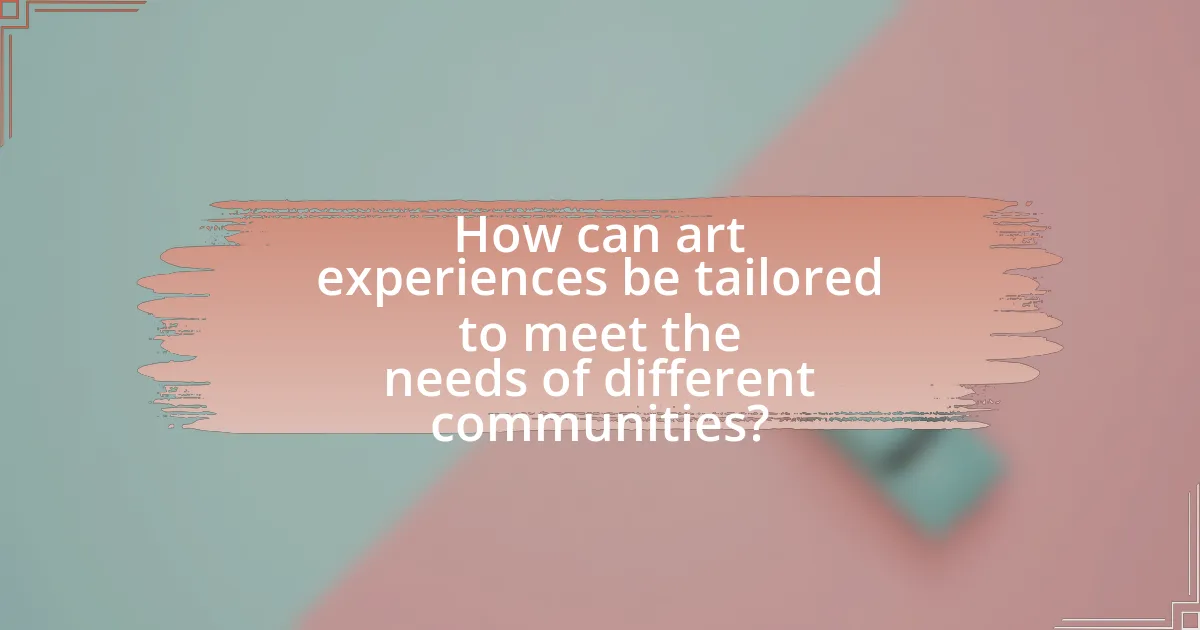
How can art experiences be tailored to meet the needs of different communities?
Art experiences can be tailored to meet the needs of different communities by incorporating local cultural elements, addressing specific social issues, and engaging community members in the creative process. For instance, community art projects that reflect local history or traditions can foster a sense of belonging and identity. Research shows that participatory art initiatives, such as those documented in “Community-Based Art Education” by K. M. McCarthy, enhance community engagement and satisfaction by allowing individuals to express their unique perspectives. Additionally, adapting art forms to be accessible for various demographics, including age, language, and ability, ensures inclusivity and relevance.
What strategies can be employed to create inclusive art experiences?
To create inclusive art experiences, organizations should implement strategies such as community engagement, accessibility enhancements, and diverse representation in programming. Community engagement involves actively involving local populations in the planning and execution of art projects, ensuring that their voices and needs are reflected. Accessibility enhancements include providing physical accommodations, such as wheelchair access and sensory-friendly environments, as well as offering materials in multiple languages to cater to diverse audiences. Diverse representation in programming ensures that artists from various backgrounds are featured, which fosters a sense of belonging and relevance among different community members. Research indicates that inclusive practices not only enhance participation but also enrich the artistic experience for all involved, as seen in initiatives like the National Endowment for the Arts’ “Our Town” program, which supports creative placemaking projects that engage diverse communities.
How can community input shape art programming?
Community input can significantly shape art programming by ensuring that the artistic offerings reflect the interests, values, and needs of the local population. When artists and organizations actively solicit feedback from community members, they can create programs that resonate more deeply with diverse audiences. For instance, a study by the National Endowment for the Arts found that community engagement in the arts leads to increased participation and satisfaction, as programs become more relevant and inclusive. This alignment with community preferences not only enhances attendance but also fosters a sense of ownership and pride among participants, ultimately enriching the cultural landscape.
What are effective methods for collaborating with local organizations?
Effective methods for collaborating with local organizations include establishing clear communication channels, aligning goals, and fostering mutual respect. Clear communication ensures that all parties understand each other’s objectives and expectations, which is crucial for successful partnerships. Aligning goals allows organizations to work towards common outcomes, enhancing the effectiveness of their collaboration. Fostering mutual respect builds trust and encourages open dialogue, which is essential for addressing challenges and leveraging each organization’s strengths. Research indicates that partnerships with shared objectives can lead to increased community engagement and more impactful art experiences, as seen in initiatives like the “Community Arts Partnership” program, which successfully brought together local artists and organizations to enhance cultural offerings in various communities.
What types of art experiences resonate with diverse audiences?
Art experiences that resonate with diverse audiences include interactive installations, community-based art projects, and culturally relevant exhibitions. Interactive installations engage participants actively, fostering a sense of connection and personal investment, which has been shown to enhance emotional responses and retention of the experience. Community-based art projects, such as murals or collaborative workshops, promote inclusivity and allow individuals from various backgrounds to express their identities, thereby strengthening community ties. Culturally relevant exhibitions that reflect the histories and narratives of different groups validate their experiences and encourage broader understanding among audiences. Research indicates that art experiences that incorporate these elements lead to higher levels of engagement and satisfaction across diverse demographic groups.
How do interactive art installations engage different communities?
Interactive art installations engage different communities by fostering participation and collaboration, allowing individuals to contribute to the artistic experience. These installations often incorporate technology and sensory elements that invite diverse audiences to interact, thus breaking down barriers related to age, culture, and socioeconomic status. For instance, projects like “The Obliteration Room” by Yayoi Kusama encourage community involvement by transforming a blank space into a colorful environment through audience participation, demonstrating how collective creativity can unite various groups. Additionally, studies show that interactive art can enhance social cohesion, as seen in community-based projects that promote dialogue and shared experiences among participants.
What role does storytelling play in connecting with diverse audiences?
Storytelling serves as a vital tool for connecting with diverse audiences by fostering empathy and understanding across cultural boundaries. It allows individuals from various backgrounds to share their experiences and perspectives, creating a shared space for dialogue. Research indicates that narratives can bridge gaps in communication, as they resonate emotionally and culturally with listeners, making complex ideas more relatable. For instance, a study published in the journal “Cultural Diversity and Ethnic Minority Psychology” found that storytelling enhances cross-cultural communication by promoting emotional engagement and reducing biases. This demonstrates that effective storytelling not only conveys information but also cultivates a sense of belonging and community among diverse groups.
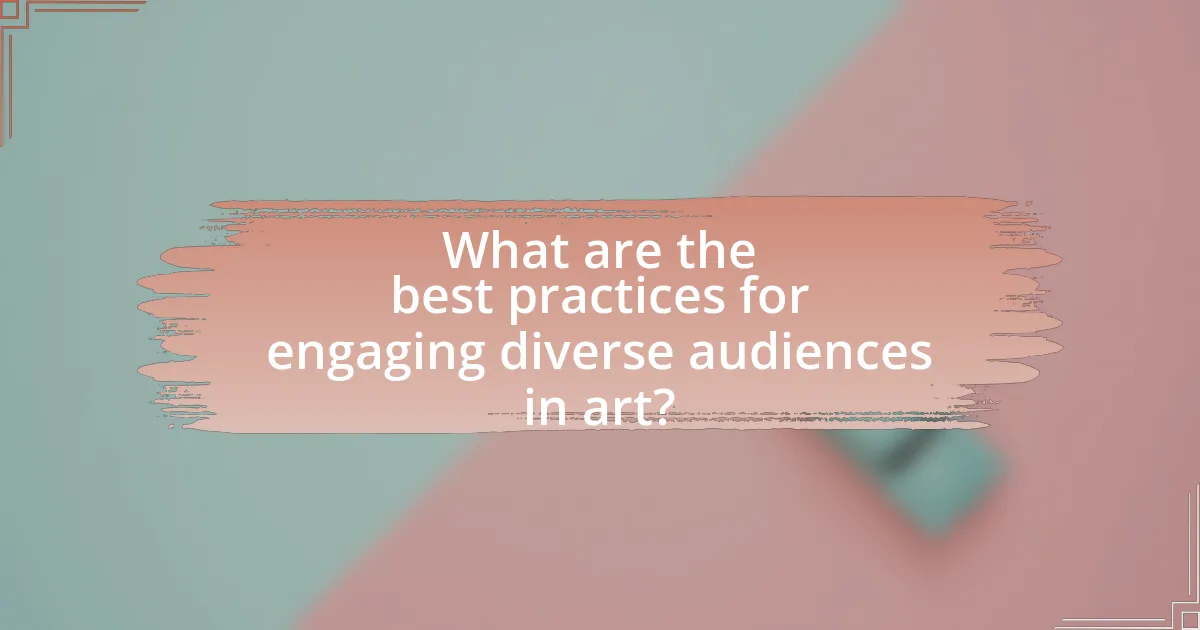
What are the best practices for engaging diverse audiences in art?
The best practices for engaging diverse audiences in art include fostering inclusivity, understanding cultural contexts, and utilizing community collaboration. Fostering inclusivity involves creating spaces where all individuals feel welcome and represented, which can be achieved through diverse programming and outreach efforts. Understanding cultural contexts is essential, as it allows artists and organizations to tailor their messages and mediums to resonate with specific communities, enhancing relatability and engagement. Community collaboration, such as partnering with local organizations and artists, ensures that the art presented reflects the values and experiences of the audience, leading to a more meaningful connection. Research indicates that inclusive practices in the arts can increase participation rates by up to 30%, demonstrating the effectiveness of these strategies in engaging diverse audiences.
How can artists and organizations measure the impact of their engagement efforts?
Artists and organizations can measure the impact of their engagement efforts through quantitative and qualitative metrics. Quantitative metrics include attendance numbers, ticket sales, and social media engagement statistics, which provide concrete data on audience reach and participation levels. Qualitative metrics involve surveys and interviews that gather audience feedback on their experiences, allowing for insights into emotional and cognitive responses to the engagement efforts. Research indicates that organizations employing both types of metrics can achieve a more comprehensive understanding of their impact; for instance, a study by the National Endowment for the Arts found that organizations that utilized audience surveys reported a 30% increase in perceived community value of their programs. This combination of metrics enables artists and organizations to assess not only how many people they engaged but also the depth of that engagement.
What metrics are useful for evaluating audience satisfaction?
Useful metrics for evaluating audience satisfaction include Net Promoter Score (NPS), Customer Satisfaction Score (CSAT), and engagement metrics such as attendance rates and feedback surveys. NPS measures the likelihood of audience members recommending an experience, providing insight into overall satisfaction. CSAT gauges immediate satisfaction levels through direct feedback after an event or experience. Attendance rates indicate interest and engagement, while feedback surveys collect qualitative data on audience perceptions and preferences. These metrics collectively offer a comprehensive view of audience satisfaction, enabling organizations to tailor experiences effectively.
How can feedback be effectively gathered from diverse audiences?
Feedback can be effectively gathered from diverse audiences by employing a combination of targeted surveys, focus groups, and community engagement initiatives. Targeted surveys can be designed to address specific demographic characteristics, ensuring that questions resonate with various cultural backgrounds and experiences. Focus groups allow for in-depth discussions, providing qualitative insights that quantitative surveys may miss, and can be tailored to include representatives from different communities. Community engagement initiatives, such as workshops or public forums, foster an inclusive environment where participants feel valued and heard, leading to more honest and constructive feedback. Research indicates that organizations that actively seek input from diverse groups see improved satisfaction and engagement, as evidenced by a study published in the Journal of Community Engagement and Scholarship, which found that inclusive feedback mechanisms enhance program effectiveness and community trust.
What practical tips can enhance engagement with diverse audiences?
To enhance engagement with diverse audiences, organizations should prioritize cultural sensitivity and inclusivity in their programming. This involves actively researching and understanding the cultural backgrounds, preferences, and values of different communities. For instance, a study by the National Endowment for the Arts found that culturally relevant programming increases participation rates among underrepresented groups. Additionally, utilizing multilingual materials and offering events that reflect the interests of various demographics can significantly improve engagement. By fostering an environment that respects and celebrates diversity, organizations can create more meaningful connections with their audiences.
How can artists create a welcoming environment for all attendees?
Artists can create a welcoming environment for all attendees by ensuring inclusivity in their work and interactions. This can be achieved through accessible venues, diverse representation in art, and engaging with community feedback to understand the needs of different audiences. For instance, research shows that inclusive practices, such as providing materials in multiple languages and accommodating individuals with disabilities, significantly enhance the experience for diverse groups. By actively fostering a sense of belonging and respect, artists can effectively engage a wider audience and create a more enriching atmosphere for everyone involved.
What resources are available for artists seeking to improve their outreach?
Artists seeking to improve their outreach can utilize various resources, including social media platforms, community art organizations, and online marketing tools. Social media platforms like Instagram and Facebook allow artists to showcase their work and engage with a broader audience, with statistics showing that 73% of marketers believe that their efforts through social media have been effective for their business. Community art organizations often provide networking opportunities, workshops, and grants that can enhance visibility and outreach efforts. Additionally, online marketing tools such as Mailchimp for email campaigns and Google Analytics for tracking audience engagement can help artists refine their strategies and reach targeted demographics effectively.
